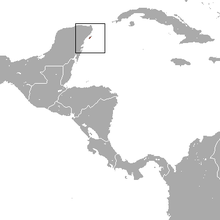Cozumel raccoon
| Cozumel raccoon | ||||||||||||
|---|---|---|---|---|---|---|---|---|---|---|---|---|

Cozumel Raccoon ( Procyon pygmaeus ) |
||||||||||||
| Systematics | ||||||||||||
|
||||||||||||
| Scientific name | ||||||||||||
| Procyon pygmaeus | ||||||||||||
| ( Merriam , 1901) |
The Cozumel raccoon ( Procyon pygmaeus ) is a rare species of raccoon that is native to the Mexican island of Cozumel .
features
The Cozumel raccoon is by far the smallest species of the raccoon genus. With a total length of 75 cm on average, the tail accounts for about 25 cm. The weight is 3 to 7 kg. This makes Cozumel raccoons around 45% lighter and 18% smaller than mainland raccoons .
Apart from the significant difference in size, there are few physical differences between the Cozumel raccoon and the mainland raccoon. These include a clear black band between the chin and throat and the golden yellow base color of the top of the tail. A shorter rostrum and, above all, a different tooth structure are anatomically significant . The teeth are only less than half the size of those of the mainland raccoon.
There is a slight sexual dimorphism in size between males and females : males are typically about 3 cm larger than females. In addition, the orange color of the neck and tail are often more luminous in males.
distribution and habitat
The Cozumel raccoon is endemic to the Caribbean island of Cozumel , which is just 15 km off the coast of the Mexican state of Quintana Roo . This 478 km² island is known to have several endemics. In addition to the Cozumel raccoon, these are the Nelson coati ( Nasua nelsoni ), a subspecies of the collar peccary ( Pecari tajacu nanus ), a subspecies of the tubercle hokko ( Crax rubra griscomi ) and the Cozumel mockingbird ( Toxostoma guttatum ).
The preferred habitat are mangrove forests . The raccoons also live in the rainforests in the interior of the island and are also seen on beaches and in agricultural fields. The proximity of human settlements is not off-putting. Overall, the Cozumel raccoon population is estimated to be 320 to 950 individuals.
Way of life
Cozumel raccoons are mostly nocturnal, but sometimes also out during the day. They are usually loners, but they can also form small groups in search of food. The action space of a Cozumel raccoon is estimated at 67 hectares.
The Cozumel raccoon is an omnivore. Crabs make up 50 percent of his diet . Other diets consist of fruits, insects and small vertebrates. Fruits of Manilkara and Pithecellobium as well as grasses of the genus Panicum have been identified as vegetable foods .
Little is known about the reproductive behavior of the Cozumel raccoon. Most births seem to take place between November and January, but also between July and August.
Systematics
Some time ago, various island species of raccoons were recognized. A detailed investigation has shown that almost all of these island raccoons were introduced by humans and are therefore not valid species. The only species whose validity is not in doubt is the Cozumel raccoon.
The Cozumel raccoon is a typical example of an island dwarf . The molecular clock suggests a separation of Cozumel and mainland raccoons 47,000 years ago. However, there is no fossil record that could shed light on the history of the Cozumel raccoons.
Existence and endangerment
The IUCN classifies the type since 2008 in the category of "critically endangered" ( Critically endangered one). This level is always given when there is reason to believe that fewer than 250 adult individuals of a species exist.
A number of sources of danger exist on Cozumel. Hurricanes in particular have a serious impact on populations. After the 2006 hurricane season, raccoons were found with external wounds and tooth injuries. For populations in the mangrove forests, these effects are stronger than for those in the interior of the island.
Although the island's forests are still largely intact, the Cozumel raccoon is also threatened by human influences. The road that runs right through the island was expanded to four lanes in 2006; many island raccoons die in traffic. Domestic dogs and in 1971 the idol snake were introduced by humans . Both occasionally kill raccoons. Dogs are also a threat because they can infect raccoons with diseases.
Individual evidence
- ↑ a b c de Villa-Meza & al. 2011, p. 88
- ^ Alfredo D. Cuarón, Miguel Angel Martínez-Morales, Katherine W. Mcfadden, David Valenzuela & Matthew E. Gompper: The status of dwarf carnivores on Cozumel Island, Mexico . In: Biodiversity and Conservation 2004, Vol. 13, No. 2, pp. 317–331
- ↑ a b c de Villa-Meza & al. 2011, p. 90
- ↑ a b de Villa-Meza & al. 2011, p. 91
- ↑ Kristofer M. Helgen & Don E. Wilson: Taxonomic status and conservation relevance of the raccoons (Procyon spp.) Of the West Indies . In: Journal of Zoology 2003, Vol. 259, No. 1, pp. 69-76
- ↑ de Villa-Meza & al. 2011, p. 89
- ^ IUCN Species Account , accessed January 1, 2012
- ↑ de Villa-Meza & al. 2011, p. 92
literature
- Alejandra de Villa-Meza, Rafael Avila-Flores, Alfredo D Cuarón & David Valenzuela-Galván: Procyon pygmaeus . In: Mammalian Species 2011, No. 43, pp. 87-93.
- R. Cays: Family Procyonidae (Raccons) In: Don E. Wilson & Russel Mittermeier (Eds.) Handbook of the Mammals of the World Volume 1: Carnivores . Lynx Edicions. 2009. p. 530. ISBN 978-84-96-553-49-1
- Víctor Sánchez-Cordero, Rodrigo A Medellín: Contribuciones mastozoológicas en homenaje a Bernardo Villa. UNAM, 2005 ISBN 978-97-03-226-03-0 (English, Spanish)
- Katherine Walton McFadden: The Ecology, Evolution and Natural History of the Endangered Carnivores of Cozumel Island, Mexico. 2004. PDF file (1.37 MB)
Web links
- Procyon pygmaeus in the Endangered Red List species the IUCN 2008. Posted by: Cuarón, AD, de Grammont, PC, Vázquez-Domínguez, E. Valenzuela-Galván, D., García-Vasco, D. Reid, F. & Helgen, K., 2008. Retrieved June 12, 2009.
